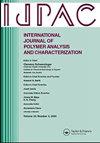废材料阻燃复合材料的表征:平衡特性和性能
IF 1.6
4区 工程技术
Q4 POLYMER SCIENCE
International Journal of Polymer Analysis and Characterization
Pub Date : 2025-07-04
DOI:10.1080/1023666X.2025.2495286
引用次数: 0
摘要
研究了废聚乙烯(wPE)和牛角灰(CHA)增强废纸(wP)作为阻燃添加剂(FRA)在阻燃复合材料(frc)中的应用效果。该研究考察了不同的CHA含量(0 wt。%至50wt %)。分析包括确定物理、机械、可燃性和热性能,以及评估表面形貌和功能基团,以评估微观结构和化学相互作用。用CHA改性wP/wPE基体,增强耐火性能和力学性能。FRC包含30wt。% CHA (FRC-30)的综合性能最好,其密度为2.89 g/cm³,硬度为623.29,吸水率为3.13%,拉伸应力模量为6.55 MPa和802.37 MPa,抗弯强度和模量分别为8.04 MPa和445.81 MPa。其阻燃性能还表现出最低的燃烧速率(1.86 × 10−3 g/s),减少的热量释放(41.20 kJ),优异的点燃时间(83.96 s)和减少的火势蔓延(122 mm/s)。FRC-30还表现出优异的热性能,热扩散系数为73.63 m2/s,导热系数为8.87 × 10−2 W/m.K。通过FTIR识别的CHA中的羟基和磷酸基团增强了界面键合,并通过扫描电镜观察到在wPE基体中的分散。这提高了机械性能和防火性能。研究得出结论,FRC-30提供了阻燃性、机械强度和热稳定性的理想组合。这使得它成为建筑、绝缘和其他工程领域的潜在候选者,在这些领域,增强消防安全至关重要。本文章由计算机程序翻译,如有差异,请以英文原文为准。
Characterization of fire-retardant composites from waste materials: balancing properties and performance
The effectiveness of wastepaper (wP) reinforced with waste polyethylene (wPE) and cow horn ash (CHA) as a fire-retardant additive (FRA) was studied for fire-retardant composites (FRCs) application. The research investigates the effects of varying CHA content (0 wt.% to 50 wt.%) on the developed composites. The analysis involved determining the physical, mechanical, flammability, and thermal properties, also, the surface morphologies and function groups were assessed to evaluate the microstructure and chemical interactions. Modifying the wP/wPE matrix with CHA enhanced fire resistance and mechanical properties. The FRC containing 30 wt.% CHA (FRC-30) exhibited the best overall performance, with a density of 2.89 g/cm³, hardness of 623.29, water absorption of 3.13%, tensile stress modulus of 6.55 MPa and 802.37 MPa, and flexural strength and modulus of 8.04 MPa and 445.81 MPa, respectively. Its fire-retardant properties also exhibited the lowest burning rate (1.86 × 10−3 g/s), a reduced heat release (41.20 kJ), a superior ignition time of 83.96 s, and a reduced fire spread (122 mm/s). FRC-30 also demonstrated excellent thermal properties of thermal diffusivity of 73.63 m2/s and low thermal conductivity of 8.87 × 10−2 W/m.K. The hydroxyl and phosphate groups in CHA, identified through FTIR, enhanced the interfacial bonding, and dispersion within the wPE matrix, as observed via SEM. This resulted in improved mechanical performance and fire resistance. The study concluded that FRC-30 offers an ideal combination of fire retardancy, mechanical strength, and thermal stability. This makes it a potential candidate for use in construction, insulation, and other engineering fields where enhanced fire safety is crucial.
求助全文
通过发布文献求助,成功后即可免费获取论文全文。
去求助
来源期刊
CiteScore
3.50
自引率
5.30%
发文量
37
审稿时长
1.6 months
期刊介绍:
The scope of the journal is to publish original contributions and reviews on studies, methodologies, instrumentation, and applications involving the analysis and characterization of polymers and polymeric-based materials, including synthetic polymers, blends, composites, fibers, coatings, supramolecular structures, polysaccharides, and biopolymers. The Journal will accept papers and review articles on the following topics and research areas involving fundamental and applied studies of polymer analysis and characterization:
Characterization and analysis of new and existing polymers and polymeric-based materials.
Design and evaluation of analytical instrumentation and physical testing equipment.
Determination of molecular weight, size, conformation, branching, cross-linking, chemical structure, and sequence distribution.
Using separation, spectroscopic, and scattering techniques.
Surface characterization of polymeric materials.
Measurement of solution and bulk properties and behavior of polymers.
Studies involving structure-property-processing relationships, and polymer aging.
Analysis of oligomeric materials.
Analysis of polymer additives and decomposition products.

 求助内容:
求助内容: 应助结果提醒方式:
应助结果提醒方式:


